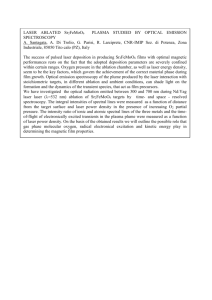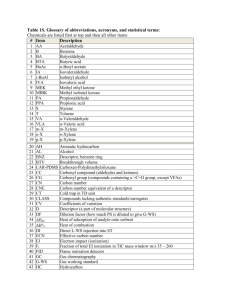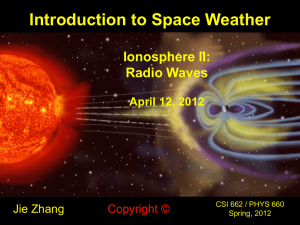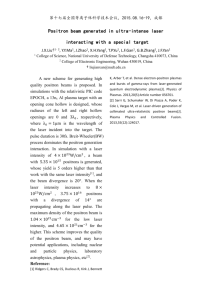Interaction of Laser Pulses with Atoms and Molecules
advertisement
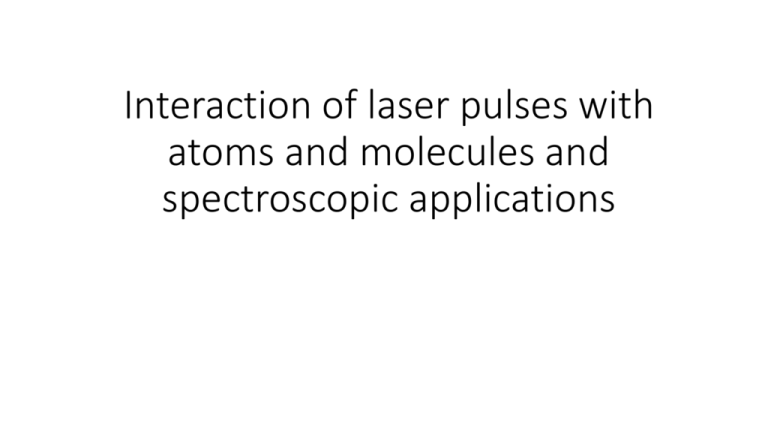
Interaction of laser pulses with atoms and molecules and spectroscopic applications Raman scattering Pump Vibrational levels 1 2 Pump Stokes 1 3 anti-Stokes Raman frequencies in spectrum due to modulation of scattered light by molecular vibrations P ( q ) E , dI P ' 0 1 2 Inelastic scattering 2 [( d P / dt ) n ] 3 4 c dI ( ' ) I0 N d( ' ) d( ' ) ' 4 q 2 d 2 Electronic-resonance Raman scattering L i , where i is resonance frequency of electronic transition Is i 1 i L 2 i 2 Is absorption coefficient Characteristic Raman shifts for different bonds A. Fadini and F.-M.Schnepel, Vibrational spectroscopy (Wiley, New York, 1989). Impulsive excitation of low-frequency modes and pump-probe study of oscillations of molecules and n-particles Spectral component (normalized) -1 =28cm 1.0 -1 =72cm 0.8 0.6 =20fs 0.4 0.2 =100fs =50fs 50 100 0.0 0 150 -1 Frequency (cm ) 200 Schematic of femtosecond spectroscopy in a pump –probe configuration Sample Pump Detector The same principle is applicable for n-particles and molecules Probe Femtosecond pump-probe spectroscopy of n-particles (d~15 nm) Spectrum Temporal response 8 Delay 0.25 7 0.20 N-particle breathing mode oscillations Amplitude, a.u. Amplitude, a.u. 6 5 4 3 2 0.15 0.10 0.05 1 0 0 10 20 30 40 Delay time, picosec 50 60 0.00 0 250 500 Frequency, GHz 750 1000 Schematic of the energy levels and optical transitions in CARS 1 1 2 , waves are all sent 1 2 3 Example: wave interaction in CARS, Phase matching conditions Requirement of phase matching condition k3=k1+k1’-k2; three waves create polarization wave (w3,k3) Coherent anti-Stokes Raman spectroscopy (CARS) Plane waves signal - nonlinear susceptibility tensor sin(kL/ 2) I CARS ~ CARS I I L kL/ 2 d 1 where CARS ~ 1 2 i d 2 2 2 1 2 2 But the CARS signal is limited by limitations on the intensity!!! The object can be destroyed. k1 vector k 2 mismatch k - 2wave 2 a For gaussian beams L~ 2 confocal parameter 2 2 d PCARS P1 P2 d 2 2 Physical values and processes for strong-field laser physics Intensity required for ionization (Ar) 𝐼 ≈ 1014 𝑊 𝑐𝑚2 Corresponding field strength 𝐸 = 1.9 × 108 𝑉 𝑐𝑚 atomic field strength (Hydrogen atom) 𝐸𝐻 = 6.1 × 109 𝑉 𝑐𝑚 New phenomena: ionization, high harmonic generation (HHG), fragmentation of molecules. Typical atomic time-scale: Bohr orbit time 2𝜋𝑎 𝜏= = 152 𝑎𝑡𝑡𝑜𝑠𝑒𝑐𝑜𝑛𝑑𝑠 𝑐 Typical displacement of an ionized electron in the laser field 𝑒𝐸 𝑥0 = = 2.7𝑛𝑚 𝑚𝜔 2 Example: bandwidth requirement for an attosecond pulse: 𝜏[𝐹𝑊𝐻𝑀] = 50𝑎𝑠 𝜏 × 𝛥𝑓 ≥ 0.44 𝛥𝑓 = 0.44 50 𝑎𝑠 =−> 𝜆 ≈ 30𝑛𝑚 ℎ𝜈[800𝑛𝑚] = 1.55𝑒𝑉 Ionization: Multiphoton and tunnel MECHANISMS Leonid Keldysh, 1964: adiabaticity parameter 𝛾= 𝐼𝑝 2𝑈𝑝 𝛾 2 >> 1, multiphoton ionization, probability 𝑃 ∝ 𝐸 2𝐾 , 𝐾 = 𝐼𝑛𝑡. 𝑃𝑎𝑟𝑡[𝐼𝑝 𝜔 + 1 2 2 2𝐸 𝑖 𝛾 2 << 1, tunnel ionization, probability 𝑃 ∝ exp − 3𝐹 Atomic system of units 𝑐 = 𝑚𝑒 = ℏ = 1 L V Keldysh, Soviet. Physics – JETP, 20(5), 1307 (1964) [Cited ≥3341 times!] 3 Multiphoton Ionization (C) Photoelectric effect Multiphoton Ionization 𝑛 photons ionize an atom: 𝑛ℏ𝜔 + 𝐴 → 𝑒 − + 𝐴+ Multiphoton condition (from Keldysh theory): 𝛾≫1 Above Threshold Ionization (ATI) Kinetic energy of the electron: 𝐾𝐸 = 𝑛ℏ𝜔 − 𝑉𝐼𝐸 Ionization probability from perturbation theory: 𝑃 𝐼 ∝ 𝐼𝑛 Courtesy of Nathan Hart and Gamze Kaya Ionization of Argon by femtosecond pulses 𝐴𝑟 + 𝐴𝐷𝐾 𝐴𝑟 + 𝐴𝑟 2+ 𝐴𝑟 3+ 𝑃𝑃𝑇 Ionization of Ar, 200 fs pulses from a Ti:sapphire laser (800 nm). The theoretical ion yields are, from left to right, calculated from Szoke’s model (Perry et al 1988), Perelomov, Popov, Terent’ev, 1966 (PPT) model, Ammosov, Delone Kraynov, 1986 (ADK) theory and strong-field approximation (SFA, Reiss, 1980). S F J Larochelle, A Talebpoury and S L Chin, J. Phys. B: At. Mol. Opt. Phys. 31, 1215 (1998) Multiple ionization of Ar at higher peak intensities of 200 fs pulses from a Ti:sapphire laser (800 nm). S Larochelle, A Talebpoury and S L Chin, J. Phys. B: At. Mol. Opt. Phys. 31 1201 (1998) Dynamics of Ar ionization by femtosecond pulses Ar Calculated ionization levels in argon for a 19 fs laser pulse at a peak laser intensity of 2.5 1015 𝑊/𝑐𝑚2 , using ADK rates: laser pulse envelope (black); Ar(blue); 𝐴𝑟 + (green); 𝐴𝑟 2+ (red); 𝐴𝑟 3+ (pink); 𝐴𝑟 4+ (brown). The right axis shows the predicted HHG cutoff energy for the chosen laser intensity, calculated from the cutoff rule (Ecutoff=Ip+ 3:2Up). Arpin et al. PRL 103, 143901 (2009) Electron trajectories after ionization Cut off for high harmonic generation (HHG) Cut off energy for HHG 𝐸𝑐𝑢𝑡 𝑜𝑓𝑓 = 𝐼𝑝 + 3.17𝑈𝑝 𝑚 𝑒𝐸 𝑈𝑝 𝑒𝑉 = 2 𝜔 2 = 9.33 × 10−14 𝐼 𝑊 𝑐𝑚2 𝜆 𝜇𝑚 2 ℎ𝜈[800𝑛𝑚] = 1.55𝑒𝑉 𝑁𝐻𝐻𝑐𝑢𝑡 𝑜𝑓𝑓 [𝐴𝑟, 1014 𝑊 𝑐 𝑚2 ] = (15.6𝑒𝑉 + 9.33𝑒𝑉 ) 1.55 𝑒𝑉 ≈ 17 𝑁𝐻𝐻𝑐𝑢𝑡 𝑜𝑓𝑓 [𝐴𝑟, 1015 𝑊 𝑐 𝑚2 ] = (15.6𝑒𝑉 + 10 × 9.33𝑒𝑉 ) 1.55 𝑒𝑉 ≈ 71 Energy of electron returning parent atom HHG in Argon (𝐼𝑝 =15.6 eV) Intensity arb. unit 80 60 (b) 21th 40 13thth 13 23d cutoff 21st 19thth 17th th 19 17 th 11th 11 15th th 15 20 0 40 50 60 70 Wavelength nm 80 • Cutoff energy is at 23rd harmonic, 𝐸𝑐𝑢𝑡𝑜𝑓𝑓 = 35.6eV (34.8 nm) • The laser power at 800 nm is 930 mW and a pulse duration 50 fs. Three step model Step 3 Step 2 Step 1 XUV Tunnel ionization Recombination Electron acceleration in laser field P. B. Corkum “Plasma perspective on strong field multi-photon ionization” P. B. Corkum, F. Krausz, “Attosecond Science” S. Haessler et. al., “Attosecond imaging of molecular electronic wavepackets” Courtesy Muhammed Sayrac Experiments on H2+ in intense laser fields (simplest molecule) • Photodissociation: H2+ + nhν • Coulomb explosion: H2+ + nhν (>1012 W/cm2) H+ + H H+ + H+ + e- At intensities the coupling between 1sσg and 2pσu becomes very strong (Pavicic, 2005)
